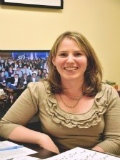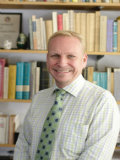|

Noga La’or
Long Island University–Brooklyn, Brooklyn, New York, USA
|
|

James Stakenburg
Rennert, New York, New York, USA
|
|

Autumn Westphal
Rennert, New York, New York, USA
|
We have been working as program administrators and teacher
trainers for a number of years. Working in a school for international
adult students, one of our main responsibilities is to deliver regular
professional development opportunities to our teaching staff. These
include prerecorded teaching tips and, more often, professional
development workshops (PDWs). In order to garner ideas for the PDWs that
we deliver on a monthly basis to our teachers, we attend conference
sessions, both regional and national, throughout the year. Despite the
fact that many of these conference sessions are extraordinarily useful
in terms of the information that is presented, we often find that we
need to tweak the format and adjust the information to fit our teaching
context, because the majority of our teachers are looking for teaching
ideas and activities that they can immediately implement into their
lessons. When creating PDWs for our teachers, we operate from the
understanding that:
- The workshops we create must relate to our teachers’ context.
- Teachers want to see practical applications/ideas in the workshops.
- We only have 1 hour to present the information.
- The information in the workshops should be easily understood and digestible.
- The workshops should also be interactive and hands on.
- The workshops should be structured in such a way that the
information is clearly presented to the teachers and after which the
teachers are given opportunities to use the material immediately in the
workshop.
Therefore, whenever working to adapt conference sessions into
in-school PDWs, these are the questions that you can ask in order to
focus yourself and create a structure appropriate for your teachers and
their teaching context:
- What should be adapted from the session so that it relates to my/my teachers’ teaching context(s)?
- What practical applications/ideas from the session would be most helpful for my teachers?
- What are the essential ideas from the session that can be
presented in 1 hour (or whatever specific timeframe your PDWs
take)?
- How can the information from the session be organized so
that it is easily presented in the time period available?
- How can I manipulate the information from the session in order to create an interactive and hands-on PDW?
An important factor to keep in mind is that these questions
should not only be asked after attending a conference session, but also
when choosing which conference sessions to attend. This, rightfully so,
becomes easier and easier the more conferences one attends, but it is
still crucial that we work hard at attending only those sessions whose
information we feel will be the most useful for our teachers.
In an ideal world, we would be able to take conference sessions
and present them just as they are to our teachers. However, as many
program administrators find, this is not always the case. Here are some
common problems that administrators may find when thinking about
adapting conference sessions into PDWs, and their accompanying
solutions.
- What should be adapted from the session so that it relates to my teaching context?
One common problem that we often find is that the information
presented in a conference session may refer to a very specific context
(for example, teaching vocabulary to university students in an English
for academic purposes setting). In order to solve this problem, it is
important to look at the material presented and think about how it can
be related directly to your teachers’ classes and specific context. In
this case, you might be able to focus on the manner in which vocabulary
is presented and practiced, but take it out of the academic English
setting, if that is not the context you are working within.
- What practical applications/ideas would be most helpful for my teachers?
What you may find is that research-oriented sessions might
present very useful information and new ideas, but not practical
applications of those ideas. A solution to this problem would be to
think of what those practical applications are and to use the practice
(not the research theories) that the research is based on as the basis
for these practical ideas. For example, if attending a research-oriented
session on the results of a study on improving student motivation
through teaching strategies, you might consider focusing on the
techniques that teachers in the study used to increase student
motivation and presenting these practical techniques to your
teachers.
Despite the fact that we may not present the research that the
ideas in the PDW are taken from in full, we do present this information
to our teachers and supply them with the background information
necessary to not only make the PDW more viable, but also to allow them
to do further research on their own.
- What are the essential ideas from the session that can be presented in [1 hour]?
Another common problem is that some sessions may be too long or
too short for the time that you have to deliver your workshops. The
solutions for these problems would be to find ways to digest the
workshop material by either selecting the most relevant information, or
combining information from several sessions. For example, you can
combine a number of techniques focusing on teaching different aspects of
pronunciation taken from different sessions. On the other end of the
spectrum, you may have to synthesize information from a 90-minute
session on innovations in teaching listening skills by omitting any
underlying theory and focusing only on those activities or ideas that
might be new for your teachers. You can always share additional ideas in
a later workshop or in a handout given at the end of the PDW.
- How can the information be organized so that it is
easily presented in the time period available?
In a conference session, the information that we see may need
to be reorganized, combined or condensed. In order to solve this
problem, it is necessary to work on reorganizing the information in such
a way that it becomes easy to present in the time period available. One
successful method is to reorganize the information with a
practical-oriented structure. This structure can take on the following
form: Information is presented to the teachers, teachers are given
controlled practice activities, and finally are able to freely apply and
personalize the information/material. We have found that teachers
attending our PDWs respond very favorably to controlled practice
activities, because these allow them to immediately see how the
information we are presenting can be applied in the classroom.
- How can I manipulate the information in order to
create an interactive and hands-on PDW?
Some conference sessions, especially if they are research
based, may not be interactive. The solution here would be to explore
hands-on, interactive ways to present content so that it becomes
practice-oriented for your teachers.
These five questions are a very useful checklist whenever
adapting conference sessions to in-school PDWs, and will help you make
your PDWs that much more relevant for your teachers.
Noga La’or has worked as an ESL teacher, academic
director, program administrator, and teacher trainer for almost 20
years. She is currently the director of ESL Programs at Long Island
University–Brooklyn, working with adult international ESL
students.
James Stakenburg is the center director at Rennert New
York. He has worked in the ESOL industry for almost 20 years as an ESL
and EFL teacher and as a program administrator, and in teacher
training.
Autumn Westphal has been working in the field of
English language teaching since 2007. She has taught English to speakers
of other languages in the United States and in South Korea. She became a
teacher trainer with the WL-SIT Graduate Institute in 2010. She
currently works as the head of teacher training at Rennert New York,
where she is responsible for training teachers, developing teacher
training curricula, and delivering professional development workshops to
Rennert teachers. |

